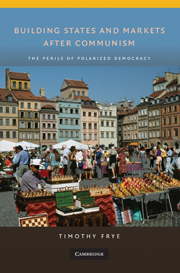Book contents
- Frontmatter
- Contents
- List of Tables and Figures
- Acknowledgments
- Introduction
- 1 The Political Logic of Economic and Institutional Reform
- 2 Political Polarization and Economic Inequality
- 3 The Pace and Consistency of Reform
- 4 Political Polarization and Economic Growth
- 5 Political Polarization and Policy Instability: The View from the Firm
- 6 Nationalism and Endogenous Polarization
- 7 Russia: Polarization, Autocracy, and Reform
- 8 Bulgaria: Polarization, Democracy, and Reform
- 9 Poland: Robust Democracy and Rapid Reform
- 10 Uzbekistan: Autocracy and Inconsistent Gradualism
- 11 Conclusion
- References
- Index
- Titles in the series
6 - Nationalism and Endogenous Polarization
Published online by Cambridge University Press: 05 June 2012
- Frontmatter
- Contents
- List of Tables and Figures
- Acknowledgments
- Introduction
- 1 The Political Logic of Economic and Institutional Reform
- 2 Political Polarization and Economic Inequality
- 3 The Pace and Consistency of Reform
- 4 Political Polarization and Economic Growth
- 5 Political Polarization and Policy Instability: The View from the Firm
- 6 Nationalism and Endogenous Polarization
- 7 Russia: Polarization, Autocracy, and Reform
- 8 Bulgaria: Polarization, Democracy, and Reform
- 9 Poland: Robust Democracy and Rapid Reform
- 10 Uzbekistan: Autocracy and Inconsistent Gradualism
- 11 Conclusion
- References
- Index
- Titles in the series
Summary
Nationalism is the last stage of Communism.
Adam MichnikRecognizing the centrality of political polarization for policy outcomes leads one to ask, Why does it vary so much across countries? A fully satisfying answer could easily generate another book, but here I pose the question for two reasons. First, I aim to begin to address concerns about reverse causation. If economic and institutional reforms are driving political polarization – rather than vice versa – then the argument made in preceding chapters is subject to challenge. To this end, I explore the sources of polarization across countries. Tracing the direction of causation in cross-national research is difficult, but the postcommunist cases are well positioned to explore this issue. In each country, initial levels of political polarization were determined by the first election after communism and therefore preceded the introduction of economic and institutional reform. That polarization predated policy choices indicates that at least initially the latter was driving the former. Whether this pattern continued later in the transformation is harder to divine.
Second, the chapter aims to add causal depth to the argument by exploring the determinants of political polarization. Satisfying explanations not only provide correlations between independent and dependent variables and identify causal mechanisms between them but also have causal depth. Independent variables should be at some temporal and conceptual distance from the dependent variable so as to avoid tautology.
- Type
- Chapter
- Information
- Building States and Markets after CommunismThe Perils of Polarized Democracy, pp. 144 - 167Publisher: Cambridge University PressPrint publication year: 2010

